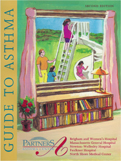Guide to Asthma
Lesson #6: Treating your asthma with medicines: The quick relievers
If asthma causes you to feel short of breath, tight in the chest, with troublesome coughing and wheezing, most often you want to have something immediately at hand to provide quick relief. The medicine to turn to is a quick-acting bronchodilator, a medicine that relieves symptoms by causing the muscles that surround the bronchial tubes to relax and the tubes to open wider.
When taken by inhalation, the quick-acting bronchodilators begin to work within 1-2 minutes. The most widely used quick-acting inhaled bronchodilator is called albuterol. It is also available by brand name (Proventil® and Ventolin®). Other examples of this type of medicine are Alupent® or Metaprel® and Maxair®. These prescription medicines (known as a group as beta-agonist bronchodilators) are preferable to over-the-counter preparations such as Primatene Mist® because they are stronger and cause fewer side-effects, especially less heart stimulation.
For adults, quick-relief bronchodilators are best inhaled (rather than taken in tablet form) because when breathed in they work quicker, provide more relief, and have fewer side-effects. To be effective, however, they need to be deeply inhaled into the bronchial tubes, not squirted onto the back of the throat. If coordinating the inhaler and timing its firing to your breathing proves difficult, you can use a holding chamber device ("spacer") to improve medication delivery. If you use a spacer with your regular preventer medicine, you can use the same one with your quick reliever.
Contrary to older teachings, it is not necessary to use your quick-relief bronchodilator prior to inhaling your preventer medication. In fact, you don't need to take the quick reliever on any regular schedule. Use it when you need it to get rid of your asthma symptoms; don't use it when you don't have any symptoms.
At a medical visit, your health care provider will probably ask you about how often you have needed to take your quick-relief bronchodilator. This information is a useful measure of how active your asthma is. Our goal is that with good asthma control, you will need to use your quick-relief bronchodilator infrequently, ideally once or twice a week or less.
Another use for your quick-relief bronchodilator is to take it 10-15 minutes before a predictable exposure to something that typically sets off your asthma. Used in this way, the quick-relief bronchodilator often can prevent tightening of the bronchial tubes that would otherwise have occurred. Preventive use of your quick-relief bronchodilator is especially effective before exercise or going out into cold weather.
Some people with asthma find that the most powerful way to inhale their quick-relief bronchodilator is as a continuous mist generated by an electric compressor and nebulizer. A liquid form of the medicine (such as albuterol) is placed in the nebulizer cup, and a mist is breathed in and out over approximatley 15-20 minutes. A lot of medicine is reliably delivered to the bronchial tubes in this way. Its major disadvantage is its lack of convenience. Unlike the inhaler, this device cannot be carried in your pocket or purse for prompt use at any time.

